|
************************************* THIS PAGE IS A TIME CAPSULE. PLEASE GO TO SCHADAVIS.ORG FOR UP-TO-DATE INFORMATION. ************************************* |
The UC Davis Domes
|
Location |
| Baggins End |
| (South of Orchard Park Cir. at Orchard Park Dr.) |
| [email protected] |
| Website |
| Established |
| 1972 |
| How to apply |
| Applications are accepted year-round on a quarterly basis! |
| Link to application is here |
| 2011 Domes Documentary |
| Part 1: http://www.youtube.com/watch?v=vfqFSVIHnF4 |
| Part 2: http://www.youtube.com/watch?v=IkfS2XfQIZY |
| 2011 Domes Community Build Weekend |
| Domes Community Build Weekend (PT.1)--UC Davis--2011 |
| Domes Community Build Weekend (PT.2)--UC Davis--2011 |
| 2012 Save the Domes Storybook |
| domes-story.pdf |
Wonder what living at the Domes is like? Watch this video!
https://www.youtube.com/watch?v=mCvUvK9sxcY
Understanding the Domes and Our Values:
The Domes at Baggins End is a living-learning community that encourages critical thought, communication and cooperation between individuals and the community, active maintenance of an open and inclusive space, and resistance to consumerism and structures of oppression.
We aim to enact these values through the following, yet are always making mistakes along the way:
- Unlearning oppressive behaviors – which includes recognizing our privileges and biases, and questioning what we’ve been told
- Taking personal responsibility for self-education and introspection
- Learning from one another, and educating others outside the community
- Encouraging experimentation with yourself, your interests, and the space
- Being patient with ourselves and others
- Sharing our resources – time, tools, meals, and knowledge (when we are able)
- Creating a space for self-care
- Providing affordable, low-income housing
- Supporting each other as students in our various academic pursuits
- This is not a space for prejudices, stereotypes, violence, and/or oppressive language or behavior towards any one race, ethnicity, gender identity, sex, sexuality, ability (social, mental, physical), socioeconomic class, age, size, religion, or citizenship status
- Respecting one another’s needs – space, noise, cleanliness, and other personal preferences
- Being open to changing your mind and not getting everything you want – while prioritizing some people’s needs over your own
- Resisting consumerism and production-based mentality – growing our own food, seed saving, food preservation, communal dinners, composting, greywater, energy reduction, freecycling, reusing, communal tools, and so on…
==> Consider how growing your own food challenges corporate dominance of people, cultures, and land
- Recognizing the intersectionality of ideas and movements and promoting solidarity between them
The Domes are always looking for applicants!
Are you interested in living at the Domes? Well, we are looking for applicants like you who are open to learning and unlearning together. If our values above speak to you, please send us an application or come to a community dinner Monday-Thursday at 7 pm -- or both! And remember, we aim to create a safer and more compassionate space that is not tolerant of prejudices, stereotypes, violence, and/or oppressive language or behavior towards any one race, ethnicity, gender identity, sex, sexuality, ability (social, mental, physical), socioeconomic class, age, size, religion, or citizenship status
Rent is $540 a month with a one time $540 security deposit. The lease is one year starting Sept 1st. Typically, the spaces are open at the beginning of each new school year, but there are regular spots available at the end of the quarters. We ask that applicants attend potluck dinners, Mondays-Thursdays at 7:00 at the Yurt or visit during to our work parties. Our work parties occur every other Sunday, from 9am-3pm (including breakfast and lunch). If you have any other questions, please contact us at [email protected]!
| Please click here to apply |
About the Domes
The Domes, (AKA Baggins End Innovative Housing), is an on-campus cooperative housing community designed by Ron Swenson. Consisting of 14 polyurethane-insulated fiberglass domes located in the Sustainable Research Area at the western end of Orchard Road, it is home to 26 UCD students. It is one of the only student co-housing cooperative communities in the USA and is an early example of the modern-day growing Tiny House/Small House Movement.
The Domes opened in the fall of 1972. According to Doug Ryen, who oversaw the Domes for UC Davis for a number of years, the community was proposed in the 1960’s by a group of students who wanted to create less expensive housing options on campus. “A few different proposals were made by designers/builders for ways to accomplish this. Ultimately the dome style was chosen.”
“The buildings were constructed primarily by student volunteers under the direction of the contractor who proposed and designed the domes,” Ryen elaborated. There were to be 15, but the project ran over budget so the last dome was never built. Because this dome was labeled Dome #1 on construction plans, it led to the domes current quirky numbering from 2-15. The construction took about one year, and the students who volunteered their time and labor were the very first residents of what was to become the sustainable community of Baggins End.
This is what the Domes looked like in the beginning. Here are some photos of the birth of the domes.
The Domes Archives lived in Herb Hall (the storage shed) until 1997, when they were transferred to the UCD Library Special Collections. There were approximately 15 boxes of photos and historical documents transferred at that time.
After a brief closure in the Fall of 2011, a lease between UCD and Solar Community Housing Association was signed. After renovations, new residents moved back in during January of 2012 http://www.davisenterprise.com/local-news/ucd/dome-homes-take-on-residents-personality/. Come by soon and check the Domes out for yourself.
 The Herb Garden in 2013
The Herb Garden in 2013 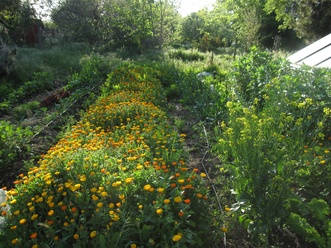 South Side Garden flourishing in 2013
South Side Garden flourishing in 2013 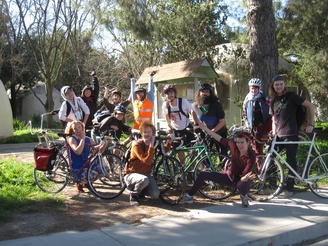 Domies bike to Winters together!
Domies bike to Winters together!
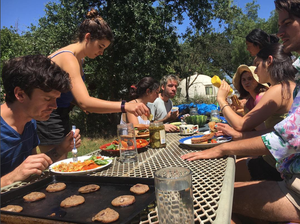 Domie potluck dinners held Monday-Thursday at 7 pm!
Domie potluck dinners held Monday-Thursday at 7 pm!
Domes Facts
- Established: 1972
- Number of residents per dome: 2
- Number of domes: 13 residential domes, 1 office dome (numbered 2-15)
- On the western edge of campus; campus grew around them
- Dome Amenities: Loving neighbors, organic garden, Kitchen, Bathroom (shower or bathtub), Living room, 2 Bedrooms (varies by dome), heating, skylight (some domes), freedom to perform your own dome construction ...
- Community Amenities: Organic gardens, materials yard, tree forts, love, fruit trees galore, community dinners, fire pit, rope swing, best free pile ever, garden tool shed, construction tool shed (with power tools), compost, greenhouse, freedom to build most anything you want, herb garden, ... the nicest chunk of land on campus.
- A large common green in the center
- Decision process: consensus
- The Domes always have Monday-Thursday potluck dinners at 7 pm Anyone is welcome to come!
- Must be a UCD student to live here
Each of the 13 residential domes has a living area, kitchen, bathroom, and loft and can house two students. According to Ramona Pulido, who wrote an article about the domes last year, each dome was constructed of three to four inches of polyurethane foam surrounded by a fiberglass shell that serves to protect inhabitants from outside elements. The white exterior and thick insulation keep them cool in the summer and warm in the winter. Although this construction may sound exotic, it is quite similar to most small boat hulls built since the first half of the 20th century.
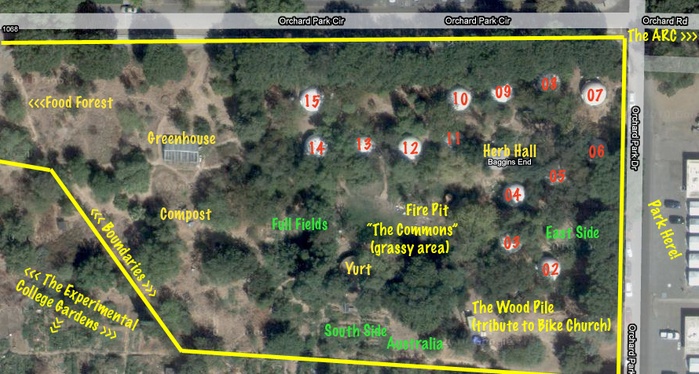 Notice the Yurt in yellow near the middle. This is where most community dinners occur during the winter. Parking is on the right (to the east of the property).
Notice the Yurt in yellow near the middle. This is where most community dinners occur during the winter. Parking is on the right (to the east of the property). 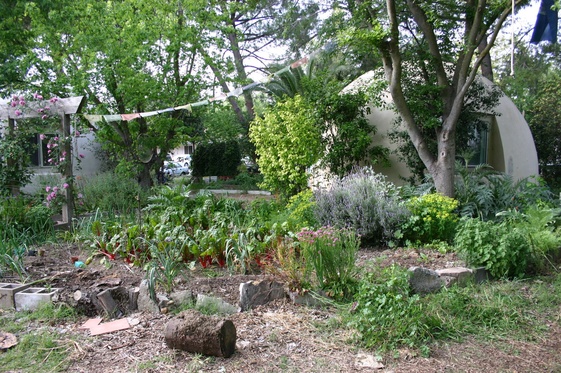 Domes 9 and 8
Domes 9 and 8
Education at the Domes
Critical Conversations in the Yurt
In the past, residents of Baggins End hosted a speaker series called Critical Conversations in the Yurt, with the hopes that the discussion forums would provide an opportunity for thoughtful and engaging conversation around various issues that affect the well-being of our local and global communities. Discussions would precede or follow a 7 pm potluck dinner at the Baggins End (Domes) community yurt, which is located on the property commons. The Domes property is located on the southwest corner of Orchard Park Drive and Orchard Park Circle, west of the ARC and east of West Village.
Spring 2013 speakers
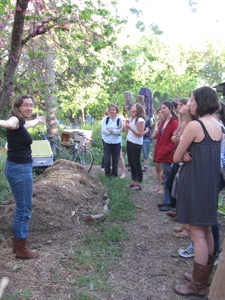 Kat Anderson shows students a native redbud plant Kat Anderson is the national ethnoecologist of the United States Department of Agriculture's Natural Resources Conservation Service and a lecturer in the Department of Environmental Horticulture at UC Davis. She is also associate ecologist with the Agriculture Experiment Station and on the Faculty in the Graduate Group in Ecology and the Faculty in the Graduate Group in Geography at the University of California, Davis. She reconstructs the plant uses, harvesting strategies, and land management practices of indigenous peoples in the United States with an emphasis in California. This work involves the use of both qualitative and quantitative research methods. A unique feature of her research is the use of the western scientific experimental approach to simulate indigenous horticultural practices and assess their potential environmental effects on the productivity and yield of wild plant populations. This information in turn can be used to assess the potential application of traditional ecological knowledge for restoring traditional gathering sites, and the biodiversity of degraded ecosystems.
Kat Anderson shows students a native redbud plant Kat Anderson is the national ethnoecologist of the United States Department of Agriculture's Natural Resources Conservation Service and a lecturer in the Department of Environmental Horticulture at UC Davis. She is also associate ecologist with the Agriculture Experiment Station and on the Faculty in the Graduate Group in Ecology and the Faculty in the Graduate Group in Geography at the University of California, Davis. She reconstructs the plant uses, harvesting strategies, and land management practices of indigenous peoples in the United States with an emphasis in California. This work involves the use of both qualitative and quantitative research methods. A unique feature of her research is the use of the western scientific experimental approach to simulate indigenous horticultural practices and assess their potential environmental effects on the productivity and yield of wild plant populations. This information in turn can be used to assess the potential application of traditional ecological knowledge for restoring traditional gathering sites, and the biodiversity of degraded ecosystems.
Alison Alkon received her PhD from UC Davis and is now an Assistant Professor in the Department of Sociology(specializing in food systems) at the University of the Pacific. She has published numerous articles on food, race and environmental justice. Her most recent book, Black, White and Green: Farmers Markets, Race and the Green Economy was just released this year. Additionally, Alison is a Domie of years past.
Kristina Lyons received her Ph.D. in Anthropology at UC Davis. Her dissertation is an ethnography of human-soil relations among scientists and small farmers in the Andean-Amazonian region of Colombia. She was recently awarded the University of California President's Postdoctoral Fellowship. She is now affiliated with the Anthropology Department and the Institute for Science and Justice at UCSC. Kristina will share an excerpt of her dissertation entitled: Soil Practitioners and "Vital Spaces": Agricultural Ethics and Life Projects in the Colombian Amazon.
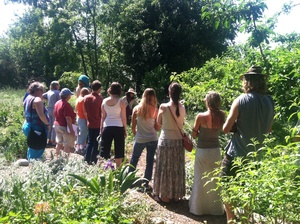 Leslie Gardener teaches students and community members using the Domes herb garden Spring 2012 speakers
Leslie Gardener teaches students and community members using the Domes herb garden Spring 2012 speakers
Mark Van Horn, director of Student Farm for over 20 years, and Damian Parr, UCD alum and crucial partner in the creation of the new undergraduate major, Sustainable Agricultural Farming Systems (SAFS), will discuss student initiated endeavors in the context of their work with Student Farm and SAFS, including structures and protocols to ensure student agency and voice in the development process for future projects, such as the Domes.
Micheal Dimock is the president for Roots of Change, an organization created with the intent of growing a network of diverse stakeholders united by the vision of healthy, affordable, safe, just and ecologically responsible food and agriculture in California by the year 2030. Michael has focused on food and agriculture since 1989, and is internationally recognized as a thought leader, organizer, and advocate for the transformation of food and farming systems. He discussed the parallels between the financial system and the food system and how Roots of Change works for change, both strategically and tactically.
Jesse Drew, Associate Professor of Cinema and Technocultural Studies here at UCD is a contributing author of the newly released book, West of Eden: Communes and Utopia in Northern California. Ramsey Kannan is a principal figure within PM Press, the publisher of West of Eden, and has a long involvement in independent publishing and activism. The book charts the remarkable flowering of communalism in the 60s and 70s, fueled by a radical rejection of the Cold War corporate deal, utopian visions of a peaceful green planet, the new technologies of sound and light, and the ancient arts of ecstatic release. The ideas expressed in the book will be presented in the context of present UCD cooperative communities.
Leslie Gardner is a renowned herbalist who wrote the book, Life in the Medicine: A guide to growing and harvesting herbs for medicine making. She has managed the gardens and taught at the California School of Herbal Studies, Forestville, CA for 18 years. She also directs the Sonoma County Herb Exchange, a clearinghouse for medicinal herb growers and their customers. Join us as she will discuss all aspects of medicinal herb growing, from seeding to harvest, concentrating on the herbs that we can grow well in Yolo County, their cultivation requirements, medicinal uses, correct harvesting for the best medicinal potency, medicine making, and markets for selling and distributing what you grow.
Academics
The Domes has long been a center for independent student learning that has earned University credit. Some students have chosen to gain independent study/internship credit at the Domes for a number of creative projects including: landscape maintenance, bee-keeping, and sitting on the board of the housing cooperative non-profit that manages the Domes property. Some of the classes and/or projects that have occurred at the Domes as of Winter 2012 have been the following:
ESP 198: (2013-2014) The Sustainable Agriculture and Food Systems major capstone class project that focuses on institutionalizing the Sustainable Research Area with the Campus Planner, Bob Segar. CRD 198: (2013) A discussion course led by Professor Ryan Galt focused on engaging residents in community research. Experimental College course on Herbal Medicine: (2013) taught by renowned herbalist, Leslie Gardener who first taught in Davis through the Critical Conversations in the Yurt speaker series. ECI 189/CRD 198: (2012) Community Processes for Sustainability taught by Frank Loge, Associate Professor of Civil and Environmental Engineering, and Ryan Galt, Professor of Community Development, focusing on institutionalizing the Sustainable Research Area (SRA). ECI 127/128: (2012) Planning of Green Civil Systems taught by Frank Loge, Associate Professor of Civil and Environmental Engineering, aimed at designing a new structure (and associated water, waste-water, energy systems, and landscape for Baggins End. LDA 181: (2012) a landscape architecture studio class, taught by Stephen Wheeler, that designed plans for a Sustainable Living/Learning Community in the Orchard Park Drive area. ESLP: (ongoing) Education for a Sustainable Living Program, a two unit seminar course, frequently tours the Domes and host a DIY workshop at the end of each quarter on the property.
Beekeeping
The Domes community historically raised bees, crucial to the well-being of our environment. There are several hives on Domes land as well as a bee garden that is landscaped with several species of plants that nourish the bee population. If you are interested in beekeeping or revitalizing the bee hives at the domes, please contact us at [email protected].
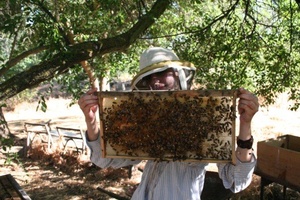 A student at the Domes holding up a rack from one of the bee boxes. It's covered in bees!
A student at the Domes holding up a rack from one of the bee boxes. It's covered in bees! Close-up of Domes bees in their bee box
Close-up of Domes bees in their bee box
History of Domes Community Build 2011
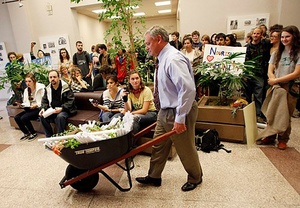 A university administrator at Mrak Hall accepts the wheelbarrows full of petition signatures, vegetables, and flowers. The event was also a sit-in to find a mutually satisfying solution to the Domes' fate. Photo by Jay Erker
A university administrator at Mrak Hall accepts the wheelbarrows full of petition signatures, vegetables, and flowers. The event was also a sit-in to find a mutually satisfying solution to the Domes' fate. Photo by Jay Erker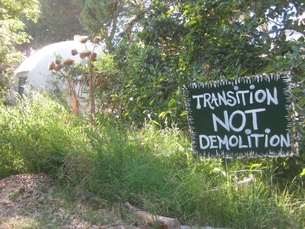 Sign of protest at the Domes' perimeterFor nearly forty years, the Domes community was managed by UC Davis Student Housing. In January 2011, an announcement from Student Housing that the Domes would be shut down - and the community likely demolished - sparked outrage and fueled a determined community to gather support for saving the Domes from demolition. For months, residents of the Domes with vast community support campaigned to "Save the Domes." Many a petition was signed; Domes solicited signatures at the Whole Earth Festival, for example. They then hand-delivered all the signatures in scroll format (all placed in wheelbarrows full of vegetables and flowers) to administrators in Mrak Hall, where they also had a sit-in. A local cooperative non-profit, Solar Community Housing Association (SCHA), stepped in to negotiate a five-year grounds lease with the University to save the community.
Sign of protest at the Domes' perimeterFor nearly forty years, the Domes community was managed by UC Davis Student Housing. In January 2011, an announcement from Student Housing that the Domes would be shut down - and the community likely demolished - sparked outrage and fueled a determined community to gather support for saving the Domes from demolition. For months, residents of the Domes with vast community support campaigned to "Save the Domes." Many a petition was signed; Domes solicited signatures at the Whole Earth Festival, for example. They then hand-delivered all the signatures in scroll format (all placed in wheelbarrows full of vegetables and flowers) to administrators in Mrak Hall, where they also had a sit-in. A local cooperative non-profit, Solar Community Housing Association (SCHA), stepped in to negotiate a five-year grounds lease with the University to save the community.
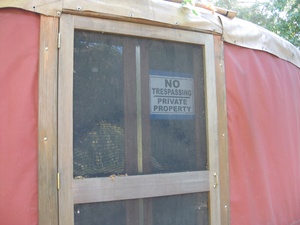 Temporary shut-down of the DomesOn November 3-6, 2011, supporters of the Save The Domes campaign organized a Community Build to renovate and repair the Domes. Volunteers, under the guidance and supervision of licensed contractors and building professionals helped renovate these landmark community structures. It was a fantastic four-day work-party extravaganza to rebuild interiors, lay wheelchair-accessible pathways, paint, garden, make and serve food, and much more. Working one four-hour shift (or more), much work was completed in just four days, minimizing costs, and keeping rents affordable at The Domes. The Davis Enterprise covered the story, and more can be read at http://www.davisenterprise.com/home-page/featured-stories/volunteers-revamp-ucd-domes
Temporary shut-down of the DomesOn November 3-6, 2011, supporters of the Save The Domes campaign organized a Community Build to renovate and repair the Domes. Volunteers, under the guidance and supervision of licensed contractors and building professionals helped renovate these landmark community structures. It was a fantastic four-day work-party extravaganza to rebuild interiors, lay wheelchair-accessible pathways, paint, garden, make and serve food, and much more. Working one four-hour shift (or more), much work was completed in just four days, minimizing costs, and keeping rents affordable at The Domes. The Davis Enterprise covered the story, and more can be read at http://www.davisenterprise.com/home-page/featured-stories/volunteers-revamp-ucd-domes
Grounds improvements
With volunteer help, many improvements were made to the Baggins End property. American's with Disabilities Act (ADA) accessible decomposed granite paths were laid around the property. Dome 8 was entirely gutted and renovated to create an incredible ADA accessible living space. Raised hugulkulture garden beds were built and planted. Local herbalist, Leslie Gardener, helped re-establish the Domes herb garden. Local artist, Mark Riviera, facilitated a community mosaic mural now in front of Dome 7.
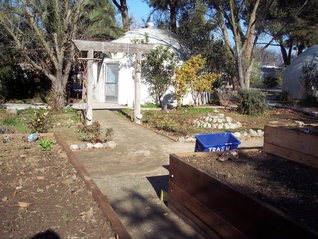 Raised garden beds with paths laid around them
Raised garden beds with paths laid around them 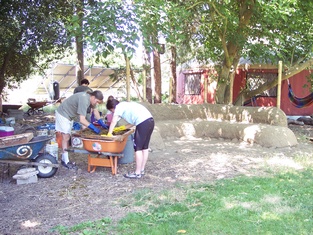 Recycled plastic bottle-brick cob bench
Recycled plastic bottle-brick cob bench 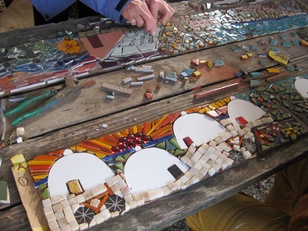 A mosaic was added as a fun, artistic part of the build
A mosaic was added as a fun, artistic part of the build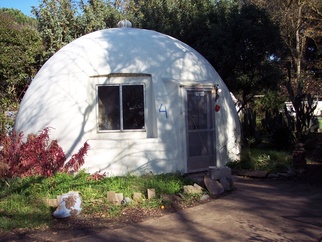 Decomposed granite paths connect all common spaces
Decomposed granite paths connect all common spaces
Dome improvements
Inside the Domes, many practical improvements were made to extend the 40-year-old living space. The lofts of all the domes were secured and outfitted with new guardrails and ladders. Foam walls were patched and repainted. Interior walls were given a fresh coat of paint and many beautiful murals were painted. Electrical outlets were updated and replaced with GFCI outlets. Dome 7 was converted into an SCHA/community office and study space.
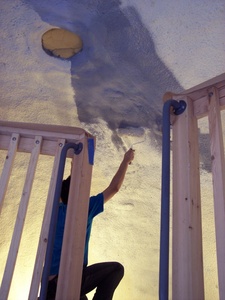 Polyurethane insulation is patched on the fiberglass dome structure
Polyurethane insulation is patched on the fiberglass dome structure 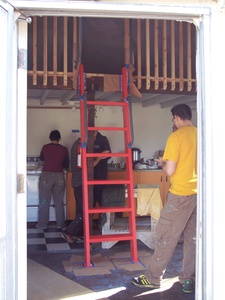 Brand new ladders and railings are built
Brand new ladders and railings are built 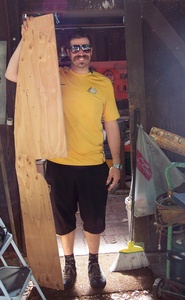 Gaps between square showers and round walls are covered
Gaps between square showers and round walls are covered  Domes get a good washing!
Domes get a good washing!
Video of the community build
• Video 1
• Video 2
Parties, music, & atypical events
Various parties for various occasions take place throughout the year and music get-togethers happen as well. The Domes hosted a Burning Bike Festival for a time .
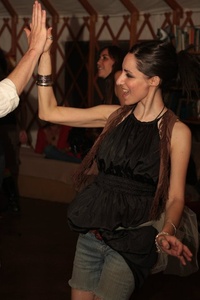 Party in the yurt, 2011, photo by Jay Erker
Party in the yurt, 2011, photo by Jay Erker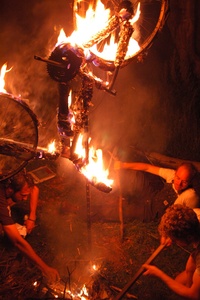 Actual charring of bikes
Actual charring of bikes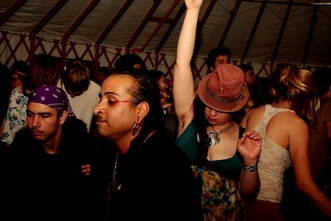 Yurt party, photo by Jay Erker
Yurt party, photo by Jay Erker Domie DJ in the yurt, photo by Jay Erker
Domie DJ in the yurt, photo by Jay Erker
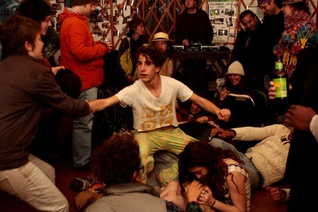 Chaotic fun in the yurt, photo by Jay Erker
Chaotic fun in the yurt, photo by Jay Erker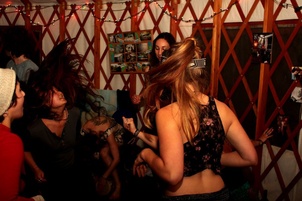 Dancing in the yurt, photo by Jay Erker
Dancing in the yurt, photo by Jay Erker
Video of music at the Domes
• Mona Mae & Brennan Blazer Bird @ The Domes -2011
• The Souterrain @ The Domes -2011
• Mona Mae & Janaki @ The Domes -2011
• Assorted folk music @ The Domes -2011
Former home of the Bike Church
The Bike Church was originally located on the Domes property. The mission of the church was to empower individuals by teaching them how to service or build their own bikes. The volunteers, many of them dubbed "ministers" of the church helped community members at a low cost or by donation, much like the reincarnated Bike Church--called Bike Forth and located in downtown Davis--is run. The university eventually dissolved the church at the Domes location due to potential fire hazard, supposedly, and other unstated reasons.
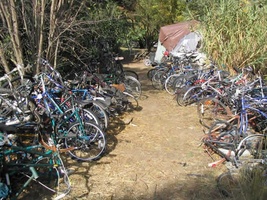 Bike chruch assorted frames. View facing north.
Bike chruch assorted frames. View facing north.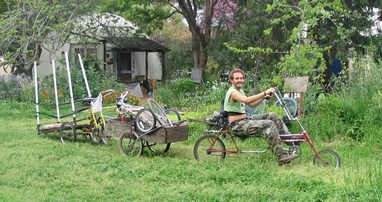 Former Bike Church minister
Former Bike Church minister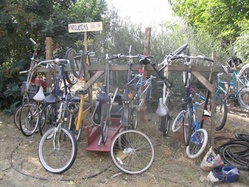 Works in progress
Works in progress
More about Domes life and reflections from former Domies
Just south of Orchard Park, the Domes has often been home to a flock of chickens. Families from Orchard Park often enjoy walking through the gardens and saying hello to the residents hens.
The residents of the Domes try to be as efficient with resources as possible. According to Amigo Cantisano, an Organic Agriculture Adviser and organic farmer, living sustainably involves “Minimizing pollution and causing the least amount of damage [to the earth] as possible; using local resources; growing your own food; eating food that is minimally processed; recycling; taking care of your health and your environment.”
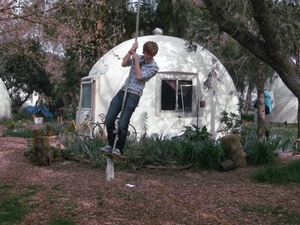 Student playing on the tree swing in front of Dome 3 in 2008In order for a community to achieve its goal of sustainability, it must work cooperatively. The Baggins End community is truly one of cooperation. Every second Sunday, the residents of the Domes gather to work together, usually in the gardens. Baggins End is part of the Student Housing Department and is owned by U.C. Davis. However, the residents do all of the work in the gardens and on the grounds.
Student playing on the tree swing in front of Dome 3 in 2008In order for a community to achieve its goal of sustainability, it must work cooperatively. The Baggins End community is truly one of cooperation. Every second Sunday, the residents of the Domes gather to work together, usually in the gardens. Baggins End is part of the Student Housing Department and is owned by U.C. Davis. However, the residents do all of the work in the gardens and on the grounds.
The Domes are home to UC Davis students of varying backgrounds and majors. Justin Regnier, a domes alumni who studied Transportation Technology and Policy, lived at the Domes for several years. According to Regnier, "Everyone does something. Gardening, pruning the trees, feeding the chickens-everyone contributes." Regnier believes that the Domes’ unique governing system is part of the appeal of the community. "The Domes are an experiment in sustainable living. We're self-governing, and all decisions are made by consensus. Communication and cooperation are important.”
In order to maintain their sustainable environment, residents of the Domes rely on consensus, a policy that requires compromise and communication that was established in the community in the 1980s. Members of the community are brought together to discuss an issue until a convergent decision is made. Rather than being a simple exercise in trading (I'll stop playing my music loud if you do your dishes), genuine consensus requires the development of relationships among members (we'll listen to music while we do the dishes together). New residents of the Domes go through non-violence and communication training, so that they will be better equipped to participate in the decision-making process. "The training teaches residents how to listen to others instead of how to make others listen," explained Regnier.
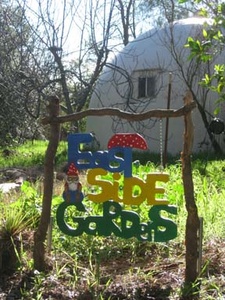 Dome gnome. Because a very important aspect of any sustainable living community is the production of food, the residents of Baggins End are especially dedicated to their gardens. Over the years, the Domes have had a variety of extensive organic gardens that are maintained by both residents and members of the community. The gardens consist of multiple areas designated for specific purposes, including an herb garden and greenhouse. An area on the western edge of the property was once called the DSA, or Domes Supported Agriculture. There residents produced the a large amount of food grown for the community. Crops such as peas, garlic, onions, potatoes, eggplant and peppers are rotated year-round.
Dome gnome. Because a very important aspect of any sustainable living community is the production of food, the residents of Baggins End are especially dedicated to their gardens. Over the years, the Domes have had a variety of extensive organic gardens that are maintained by both residents and members of the community. The gardens consist of multiple areas designated for specific purposes, including an herb garden and greenhouse. An area on the western edge of the property was once called the DSA, or Domes Supported Agriculture. There residents produced the a large amount of food grown for the community. Crops such as peas, garlic, onions, potatoes, eggplant and peppers are rotated year-round.
Rotating crops is a common practice in sustainable farming that offers huge benefits and results in higher yields. Cantisano explains that some plants require a lot of nutrients, called heavy-feeding plants, and can drain the soil of nitrogen in a short time. Legume plants, such as beans, peas, and clover, are low-feeding, and actually introduce nitrogen into the soil. Crop rotation prevents soil from becoming depleted of nutrients without having to use inorganic or chemical fertilizers.
The cob-wall greenhouse at the Domes, built by Domies and friends in 2001, is another example of the community’s commitment to sustainability. As Regnier explained, the greenhouse is constructed so that the winter sun passes through the windows and hits a heat storing rear wall. The wall is constructed of rice straw and stucco, and retains heat. As the sun goes down, the rear wall emits heat, and keeps the greenhouse warm throughout the night. In the summer, the sun travels a different path in the sky, leaving the heat-retaining wall shaded. The greenhouse stays hot, but is able to cool during the evening.
While Baggins End is a residential area, members of the community are encouraged to visit the grounds and the people who live there. “We’re here and would like to see people,” explained Regnier.
The weekly potluck dinners on Monday through Thursday has been a long-standing tradition at the Domes.
Photos
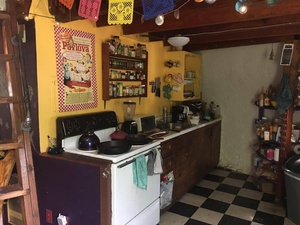 A dome's kitchen (2017)
A dome's kitchen (2017) Outside Dome 11
Outside Dome 11
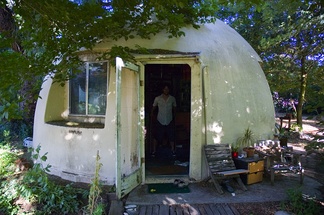 A dome with the door open (2006)
A dome with the door open (2006)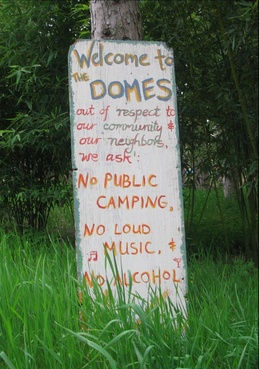 Welcome
Welcome  Chamomile, an old resident rooster (2011)A dome's living room (2017)
Chamomile, an old resident rooster (2011)A dome's living room (2017)
 View From Orchard Park Drive (2010)
View From Orchard Park Drive (2010)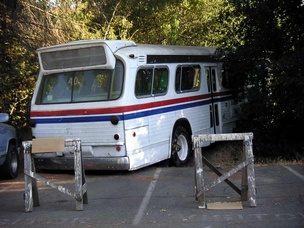 bus found next to the Domes long ago (2010)
bus found next to the Domes long ago (2010)
 Inside the Greenhouse
Inside the Greenhouse  Inside a typical dome before 2011 renovations (2006)
Inside a typical dome before 2011 renovations (2006) 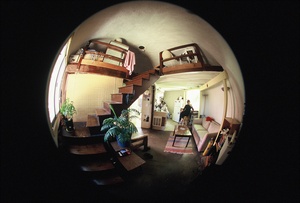 Interior before the 2011 renovations (2006)
Interior before the 2011 renovations (2006) 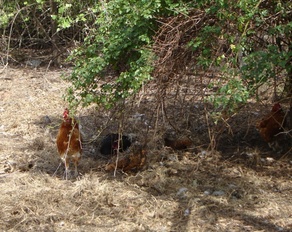 Free range, of course.
Free range, of course.
Media
- http://www.nytimes.com/2015/01/21/us/domes-at-uc-davis-counterculture-spirit-thrives.html?hp&action=click&pgtype=Homepage&module=second-column-region®ion=top-news&WT.nav=top-news
- http://theaggie.org/article/2011/05/24/domes-supporters-to-rally-for-community
- http://www.davisenterprise.com/local-news/ucd/residents-holding-out-hope-deal-can-save-ucds-domes/
- http://theaggie.org/article/2011/05/31/supporters-protest-closure-of-the-domes
- Starting at 40 minutes into the podcast: http://www.localdirtradio.com/2011/05/butterflies-climate-change-and-rally-to.html
- http://www.fox40.com/news/headlines/ktxl-students-protest-domes-demolition-20110525,0,6907819.story
- http://www.youtube.com/watch?v=p1z6f54GjhY
- http://gooddaysacramento.cbslocal.com/video/
- http://ucdavismagazine.ucdavis.edu/issues/su11/letters.html#letter_7 - UC Davis Magazine: Letters Comment Summer 2011 edition
- The Domes Discussion Continues - The Davis Voice March 11, 2011
- "Sacramento News and Review: Last Days of the Domes, Mar 10, 2011"
- Sustainability Begs Us to Save the Domes - The Davis Voice Feb. 14, 2011
- Domes Video & Article - Sacramento's CBS 13 News Feb. 11, 2011 10pm
- Domes Renovations - The California Aggie Feb. 1, 2011
- No New Leases for Domes Residents The California Aggie Jan. 26, 2011
- Cooperative Housing Properties to be Renovated - The California Aggie Jan. 13, 2011
- Davis Enterprise Feb. 2011
- There's Still No Place Like Dome Sacramento Bee 2007-08-08
- Newswatch 2008||
- The Summer of Love Lives On UC Davis Magazine Summer 2007
- http://www.davisenterprise.com/story.php?id=101.2 Recent Enterprise Article on the Domes and Focus the Nation
- UC Newswatch: The Domes
Related pages
- Residents have also been known to assist in organizing the Davis People's Free School.
- Other university programs from this era: Coffee House, Unitrans, Bike Barn, Experimental College, Whole Earth Festival.
SunjeetBaadkar
- yup. everyone's welcome to go to the dinners. —JessicaRockwell
2009-08-25 11:10:36 one time when i was really little me and my friend went over there and they let us pick their mulberries off their trees. there was this really nice girl, amie i think. and one time we were invited to have dinner. it was actually held outside and everyone brought homemade food to share. —hobojobo
2011-01-04 01:12:29 Urgent Alumni Reconnection! While both the domes and tri-coop communities are in danger in the short-term, our long-term future is looking increasingly grand if we have your support! Each One Reach One Tell EVERY ALUMNI and CORE COMMUNITY MEMBER you know to get in touch with us! Politics are climaxing our short term/long term future! We need everyone and their mom to send us an email! [email protected] (It will be used very rarely to coordinate civic action as necessary) Please let us know your full name and affiliation, and include any other contact info you'd like to share, level of interest for future involvement, resources you might offer, etc. We'll also be sending out an invitation to receive our quarterly newsletter as we develop a non-profit alumni organization.
Alumni Fund Drive: Support Future Development We're asking for alumni and our wider to community to pledge financial contribution for student-directed development at the Sustainable Research Area. Specifically, we are asking people to pledge up to $1000 (a future commitment) towards materials for the development of Domes 2.0 and the Tri-Coops renovations using student labor, provided that: 1. Students are collaboratively involved in the design and construction as part of their education. 2. The communities remain in habitation on or near the property during any construction or renovation. 3. The communities regain the privilege of managing their own budgets. Conversely, if the existing communities are evicted before development or renovation of new facilities, we are asking alumni to pledge to give NO MONEY to UC Davis at any point in the future to communicate clearly the importance of these communities. There may come a time in the next few months where we will call upon you to contact the university with your pledge. Basically: When Money Speaks the University Listens! January 8th Alumni Potluck! The time has come to think grand thoughts of our communities. Let's join together to eat nutritious, beautiful food and engage in dialogue about Domes 2.0 and Tri-Coops post ADA renovations. There will be back massages...There will be nutritional yeast... At 6:00pm, Ron Swenson (Domes designer) will be talking about the creation of the domes as a student educational endeavor in 1972 and we'll discuss the future together. There will be synapses created and energy generated! Bring a dish of something you love or just bring yourself! —EliseKane
2011-01-29 05:40:32 I knew a barber around town named Joseph Wright. He told me that he and a friend watched the domes being built. —BruceHansen
2011-02-01 17:47:59 I <3 the domes! I always have a place in my heart for unique living spaces. —Dozer
2011-02-02 23:14:50 URGENT NOTE ABOUT THE FUTURE OF THE DOMES, as sent to the Whole Earth Festival list-serv today:
Dear Alumni, Friends, and Family,
At a forum on Monday, January 24, 2011, UC Davis¹ Student Housing notified Baggins End residents that, at this point in time, no new leases will be offered. Essentially, without further action on our part (more below), by this August the Domes will be vacant. The condensed version:
A Domie-initiated move to fix foam problems in Dome 10 led to Student Housing calling a series of thorough inspections of all structures, the results of which they have used to justify their decision to deny any new leases. Our response has been to prioritize which concerns are immediate issues and which concerns are less relevant to the short-term habitability. For the long term, we are working within a newly created Sustainable Living/Learning Task Force to develop a new vision for our community, involving new structures on our property. Right now, we need help from alumni to contact administration, initiate creative problem-solving, help us gain access to an electrician and an attorney, and to pledge donations for the building of new structures. See below for more detail on how we arrived at this situation and what to do about it. The full version:
What led to this decision?
As you are already aware, the Domes are composed of a fiberglass shell with a polyurethane-based foam sprayed on the inside. The foam in 9 out of the 14 Domes is delaminating from the fiberglass shell and in need of repair. In particular, Dome 10 has the worst foam delamination. The smoke detector attached to the outer edge of the Dome opening is causing the foam at the ceiling of the loft to peel away from the fiberglass shell in such a way as to make it dangerous for a resident to live in the loft. In the 2008-09 academic year, the community consensed to move forward with a project to repair the foam. One of the community members at that time was in dialogue with Central Coating Company, the company that did the original foam spraying in 1972. It seemed that the foam repairs would be fairly easy (do-able with student labor) and inexpensive, purchasing kits that would involve cutting out the damaged foam sections and spraying in new foam.
Residents consensed to approach Student Housing to request that the materials be paid for with funding from the reserves generated from the university-controlled budget.
However, Student Housing took the project over completely. Student Housing took the foam repair project to the bidding process, stating that this was a university policy for all moderate to major (re)construction projects. The university brought several companies out to bid on the project, and none of which were qualified to do the repair work.
In spring 2010, Student Housing notified the Domes community that Dome 10 would be taken off-line until the repairs could be made. At that time the university had Mason Knowles do a comprehensive inspection of the foam in all the Domes for a fee of $6575. Mason Knowles took core foam samples from each of the Domes. The findings from this foam report can be found here: http://www.housing.ucdavis.edu/__pdf/importantinformation_domes_coops/Dome%20Foam%20Inspection%20Report.pdf In summary, the report states that the foam in all of the Domes has decayed and needs to be replaced, and if done correctly the Domes could last another 40 years.
The university sent Mason Knowles's foam report to Central Coating where they submitted a bid on the project, estimating that it would cost $43,000 to replace the foam in each Dome. This does not include the cost of gutting each Dome, which Central Coating claims is necessary, in order to do the foam replacement. (Note: If students were able to stick to the original plan of cutting out the damaged foam near the Dome hole and re-spraying with an insulation kit, it would cost approximately $600 to repair the most damaged part of Dome 10.)
In July 2010 Student Housing proposed a comprehensive inspection of Dome 10, stating that the university did not want to spend $43,000 fixing the foam of Dome 10 if there were other things that needed to be repaired. Thus, Student Housing scheduled an inspection that included: Fire Department; Environmental, Health, and Safety (EH&S); and Design and Construction Management (DCM). The findings from these reports is that Dome 10 is considered ³substandard² and that immediate safety issues such as electrical need to be addressed before residents can move back in. These three reports can be found here: http://www.housing.ucdavis.edu/__pdf/importantinformation_domes_coops/halliday%20oct%207%202010.pdf http://www.housing.ucdavis.edu/__pdf/importantinformation_domes_coops/EHS%20Dome%2010%20Report.pdf http://www.housing.ucdavis.edu/__pdf/importantinformation_domes_coops/Dome%2010%20Fire%20Report%207%2015%2010.pdf After the comprehensive internal inspection, Student Housing asked an engineering professor to take a core sample of the fiberglass shell of Dome 10. This sample was tested and found to be in relatively good condition. This report can be found here: http://www.housing.ucdavis.edu/__pdf/importantinformation_domes_coops/Dome%20Fiberglass%20Summary%20and%20Report.pdf
Based on their findings in Dome 10, Student Housing decided to do a similar comprehensive interior inspection of the remaining 13 Domes. These inspections took place on three separate dates in November 2010. These findings can be found here: http://www.housing.ucdavis.edu/__pdf/importantinformation_domes_coops/Domes%20fire%2011-10.pdf http://www.housing.ucdavis.edu/__pdf/importantinformation_domes_coops/EHS%20DOME%20Report.pdf http://www.housing.ucdavis.edu/__pdf/importantinformation_domes_coops/Dome%20Housing%20Evaluation-Dec-2010.pdf
Much like the Dome 10 inspection reports, the most immediate safety concern throughout are the electrical outlets internal to the base of the structures. This may be a relatively simple fix involving installing GFCI outlets. The problem at this point is that any ³substantial² renovation to the Domes (defined by the campus architect as something as simple as rewiring) would trigger compliance of not only all 2007 building code but also Americans with Disabilities Act (ADA) compliance for our program: http://www.housing.ucdavis.edu/__pdf/importantinformation_domes_coops/galindo%20sept%2024%202010.pdf Essentially the problems are numerous and interconnected. We are at the point where we need to address the electrical safety issues but doing so may require us to do a complete overhaul of the structures, which according to Housing¹s estimates would approach $1 million. So what are we doing about it? We've lobbied to have the long-term future of the Baggins End property addressed via the Sustainable Living/Learning Taskforce chaired by Assistant Vice Chancellor of Campus Planning Bob Segar. For more information see the charge letter here: http://housing.ucdavis.edu/__pdf/importantinformation_domes_coops/Sustainable%20Living-Learning%20Taskforce-120610.pdf This newly formed group includes administration, faculty and student residents from the Domes and the Co-ops and is charged with creating a new model for student research cooperatives. This planning process will involve coming up with a plan to build new structures at the Baggins End property in the next 3-4 years, thereby making many of Student Housing¹s longer-term concerns about the structures irrelevant. In addition to new structures, the Task Force is charged with coming up with a new vision for the program itself, which will likely institutionalize and formalize many of the educational benefits we have enjoyed at the Domes on an informal basis for the last 40 years. This planning/visioning process is just beginning, as their first meeting was last week, but we are excited by this prospect for our future.
This quarter Veronica Pardo, current Domes resident and Community Development graduate student, is co-teaching a course with Frank Loge (Associate Professor of Civil and Environmental Engineering) called Community Processes for Sustainability, focusing on institutionalizing the Sustainable Research Area (SRA). Concerning ADA compliance, a group of Domies and Co-opers, in collaboration with the Cooperative Advisory Board (CAB), drafted this plan to counter the budget put forward by Housing: http://housing.ucdavis.edu/__pdf/importantinformation_domes_coops/CAB.ADA.plan.2010.12.6.pdf http://housing.ucdavis.edu/__pdf/importantinformation_domes_coops/Appendix.III.Domes.Transition.Budget.pdf Our long-term prospects look decent, thanks to the Sustainable Living/Learning Task Force, but it's the short-term that is more problematic. To deal with this, we are acting on many fronts and the details are changing daily. Following are some of the bigger themes. We are in the process of writing by-laws for the incorporation of a SRA into a non-profit or possibly an Organized Research Unit (ORU), which is essentially an on-campus research-related non-profit, which would provide a management structure to extricate ourselves from Student Housing. We are requesting an itemized reassessment of what in the inspection reports constitutes safety hazards that need to be dealt with immediately versus items that are ³substandard². We are in contact with Mason Knowles regarding reassessment of the scope of re-foaming that would be necessary for continued habitation over the next 3-4 years, until existing structures are replaced with new ones. Additionally, we are contacting several other structural engineers for a second opinion on the safety of the current foam conditions. We are in contact with Ron Swenson the original Project Manager for the construction of the domes regarding more creative (and cheaper) fixes for the foam.
What do we need from you? We are reaching out to our pool of highly skilled and diverse alumni/concerned community members for help at this urgent time of need. Baggins End has always attracted the most unique and effective community members and the passion and skills of these alumni can help to ensure the continued existence of the Baggins End community. The effect of concerned alumni was obvious during the Long Range Development Plan meetings in 2000 in which concerned alumni wrote letters to the University and attended community land planning forums. No doubt, the voices of alumni are urgently needed now and can potentially affect the University planning process immeasurably, complementing the efforts of current students. As the needs of the Baggins End community are varied and robust, so too are the skills, viewpoints, and talents of the Domes alumni, and everyone has a chance now to make their voice heard. Potential Ways in Which Alumni/Concerned Community Members Can Help:
-
Write a letter! Or send in a multimedia message of your choosing to University Administrators.
Linda Katehi, Chancellor: [email protected]; (530) 752-2065 Fred Wood, Vice Chancellor of Student Affairs: [email protected]; (530) 752-6866 We encourage you to be creative but concise/succinct in your message in order to effectively grab the attention of UC administrators. Let them know that you care about the continued existence of the Baggins End Community and perhaps how living at the domes affected your education/life. Please feel free to include your vision for the future of the community and if inspired, talk about how your alumni contributions to the University may hinge on the fair treatment of current community members as well as the University's commitment to the vision and substance of the Baggins End community for the last 40 years. One of the most unique aspects of the Domes community has always been the density of the cooperative, consensus-based housing. While there may be reasons to increase the density of housing on the property or to increase the footprint of the community in order to increase the number of potential community members, many people who have lived at the Domes and participated in meetings can appreciate that consensus appears to work best within certain limits and conditions for which the current layout of 14 discrete dwellings, each with 2 community members, appears perfect. The Domes have always been special within the co-op world for this unique setup of small private spaces surrounding and coming together to make a larger tribal whole. And any thoughts on how this unique and nurturing arrangement may have helped you to find your voice, be a better local/global community member, or succeed in your life/career are potentially very important right now.
-
Are you a licensed electrician?
We would like to do our own independent assessment of current safety issues and affordable fixes. Please find contact information at the end of this letter to get in touch with us if you can help us with this.
-
Are you an attorney and would like to donate some of your skills/time?
A legal advocate would be instrumental in helping to clarify the complicated relationship between the domes and student housing, SRA non-profit status, and ADA compatibility. Please find contact information at the end of this letter to get in touch with us if you can help us with this.
-
Pledges
Additionally, we are in the process of creating a community-based nonprofit to which pledges can be made to fund the next generation of domes structures. Our message as current community members and alumni becomes far more powerful if we can match or produce funding to help shape our vision for the community. Please find contact information at the end of this letter if you are able to contribute a pledge. More information to follow. Thank You! Together we can save the Domes! In solidarity, The 2010-11 Domes Community Contact: [email protected] Facebook group: The Domes Family
2011-02-03 09:55:22 I always wondered why it was called "Baggin's End" Obviously it is derived from the Lord of the Rings but in those books Bilbo Baggins' home was called "Bag End". —DagonJones
-
Maybe they were worried about getting sued by Tolkien. lol
- Tactical Studies Rules (aka TSR) got threatened with a lawsuit for using hobbits, balrogs, ents and orcs in D&D. Details here. ⁓ʝ⍵
2011-02-04 12:16:39 Rik Keller Photography uploaded photos from the DomeRaiser event at the Delta of Venus on Friday Jan. 28 here: http://www.rikkeller.com/Events/DomeRaiser-1-28-2011/15704999_Y3nUX —RikKeller
2011-02-15 14:56:11 Perhaps I just don't understand the issues clearly - but isn't Student Housing just closing the domes for 1 year to do some upgrades? How does that translate into the Domes disappearing?? —redbike
Response: The plan to build new structures is set to happen within the next five years. By vacating the Domes in the meantime, the University will destroy the historical legacy of the Domes by interrupting the important flow of knowledge and practice from on generation of Domies to the next. Additionally, by clearing out the community, it will be much easier for the University to subvert the process of rebuilding, either by cancelling it altogether or deciding to just replace the structures with, say, dorms... —TomDenton
2011-03-13 21:34:24 2011-03-13 21:29:22 I know, I am going to be viewed as a pariah by some and not so much by others but I personally see no reason not to eliminate them and/or replace them. They are sub-standard for living at best at this point, are run-down and completely outside of regulations and need to be replaced.
Yes, it is a sad thing to have this ever rotating community lose it's current housing situation, but then again... Is it really so?
I mean, bottom line is that that students live in this co-op, not the Davis community at large. Students who are always moving on and moving out and a new batch moving in each and every year. So in all honesty, the only people being affected by this are the current residents who may not even be residents in these units next year whether they exist or not. So who does it truly impact? The University, that's who. While they might be slightly off the normally tread path, they are still taking up University space, are technically University property and fall under University scrutiny and purview. There are multiple co-ops available for residents throughout the city of Davis, this one just happens to fall under the category of University discretion.
So what is really the problem?
I can understand that, as far as local history goes, the Domes may have their place. If this is the main concern of residents at large, then perhaps they could convince the city to work something out with the University to preserve or move one or two of the units to a new location to be preserved for this purpose. Aside from this, there is absolutely no reason whatsoever for this to be an issue. —Wes-P
Wes P, I agree. —abybabe76
2011-04-14 19:51:11 With the state budget what it is, I can't understand how these students feel the University should invest so much money in a project for under 30 students when they are forced to lay off their employees to meet budgetary needs. Yeah in an idealic world they should be kept, but it's just not realistic given the financial siatuation of the state. It's a lot easier to find a new place to live than it is a job nowadays. —abybabe76
"2011-04-21 12:45:00" The Domes costs UC Davis nothing. It requires no UCD investment. It is a self-sustaining housing project, which pays into its own reserves and also pays approximately 10% overhead from their rents to pay for general UCD administration. The current maintenance and renovation needs can easily be met for 1/10th of Student Housing's estimates — but UCD officials have prevented Domies from doing the repairs & maintenance that they have always done, since the 1970s. They even sent some students to Judicial Affairs for repairing a dome.
This issue is not about the Domes costing UCD money. If anything, it's about a cultural disconnect between UCD admin and the residents. In fact, if will cost approximately the same amount ($40,000) to demolish the domes, whereas maintenance & improvement according to the student/faculty/community plan would cost only $58,000. The Domies have already raised the additional $20,000 to make it work, and has over $40,000 in reserves already. Students have the money to maintain & renovate the property — they just need administration to stop preventing them from maintaining their homes. — danfodor
2011-05-03 16:35:18 Shady UC land grab / way expensive estimates are shady! So is preventing maintenance that will suffice
but then again we all know the regents suck and will do what they want whilst making high 6 figures —StevenDaubert
2011-05-22 10:22:12 The UC has become a really disappointing system these days. This is mainly an example of their reevaluation of land usage and the realization that they could benefit more from destroying the principles that tie the Davis community and school together, not to mention what is a historically unique to the school itself. Shame on UC Davis, your past is how you move forward to deny it or try to emerge from it without recognition is to completely forget what has contributed to it as a thriving school, the communities that make it up. Someone might want to look into the school feeling that the fiscal benefits are better being a commuter school than actually having live-in students because most of the students I meet now are all just commuters and mere transients to this community, don't know but it might be interesting.
- CBS 13 at 5pm just aired a little segment on the Domes on Wednesday June 8,2011. — NikhilDahal
2011-06-17 05:15:36 As an Alumni of UC Davis and contributor to the school I was really disappointed to hear about this from a BART passenger recently. I was in shock and disbelief actually. Having worked for Student Housing I have a general idea of how much net profit they make per year and how shady this organization is. The Colleges at La Rue were once owned and operated by the University to be later sold to Tandem a private company, I think that's akin to selling one of the campus lecture halls to Donald Trump (ie someone's making loads of money at the cost of student's tuition costs). The domes were a great place to visit when I was a student and really a unique place that fostered creative thinking and ideas. It should be viewed more as a place of learning rather than just a set of houses or a plot of land that could be better financially utilized (some things have greater value undeveloped like the quad for example just a patch of undeveloped land that no one would suggest putting a dorm in the middle of). Anything put in place to replace it will likely not be as organic as the domes were. I will stop donating to the university and stop encouraging people I know to go to school there. It seems pretty apparent that the people running the school now are the same corporate minded individuals that are driving the rest of the country down the drain. —heyitsdimo
2011-10-28 21:45:45 I am so happy to hear that the domes will live on!!! If I lived in Davis I would be volunteering! This has put one huge smile on my face!!! —Dozer
2011-11-05 00:08:15 I heard the volunteers were out there today. —BruceHansen
2012-01-20 23:30:15 Domes reopened a couple weeks ago under Solar Community Housing Association five year ground lease, right now half of them are inhabited and work is continuing on the remainder for the next few months. —AlfredTwu
2012-03-09 19:49:16 Just noticed that the bagginsend.org website links no longer work, with the exception of the one on the Community Build that redirects to http://schadavis.org/domes-community-build. Not sure if the website is only temporarily down or permanently changed. —bethjoyce
Footnotes
1. Dome 1 was originally designed with a wooden pad, but the university did not consider it an acceptable foundation material. The pad temporarily housed an office during the build. Ultimately, there was not enough money to complete Dome 1 and the Domes are numbered accordingly.
2015-11-09 11:08:25 The Domes has vacancies for Winter 2016 and is seeking applicants. Please come by for dinner (Mon-Thurs at 7 PM) to meet us and send in an application! We aim to make decisions by Nov 23, 2015 so please get in touch soon if you are interested. —hdfisher


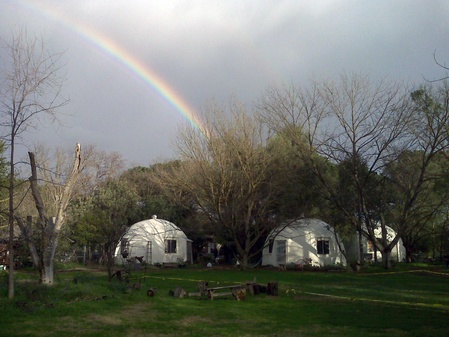



Comments:
You must be logged in to comment on this page. Please log in.